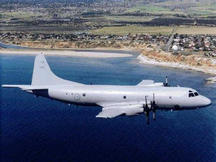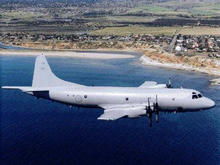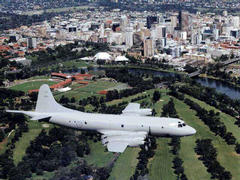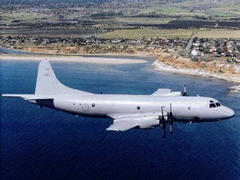Article 13
The map (courtesy of Elaine Scarry) shown here below depicts the areas where the events described in the article unfolded. It shows the flight paths of the three aircraft.
The following are images of P3 aircraft that are also mentioned in the article. One type of P-3 carries extremely high-powered transmitters and may be closer to an electronic warfare plane. Was there a P3-factor in the tragedies mentioned in the article below?
A P3 in flight. Click on the image for an enlarged version.
A P3 in flight. Click on the image for an enlarged version.
A P3 in flight. Click on the image for an enlarged version.
A P3 in flight. Click on the image for an enlarged version.
A P3 in flight. Click on the image for an enlarged version.
WERE THESE AIR DISASTERS CAUSED BY ELECTROMAGNETIC POLUTION?
Coen van Wyk
During a period of three years and three months, commencing on 17 July 1996, only three large passenger aircraft taking off in the United States, crashed and all three aircraft took off from JFK International Airport. Apart from the fact that the three stricken airliners took off from JFK International Airport, there are other facts, common to the crashes, that may point to Electromagnetic Interference ("EMI") in the airspace through which they travelled, as the reason for the tragic events that caused the loss of life of 676 people on board.
The particulars of the three crashes are as follows:
· On the 17th of July 1996 TWA 800 took off from JFK International Airport and just twelve and a half minutes into its flight, it fell into the ocean south of Long Island.
· On the 2nd of September 1998, Swissair 111 took off from JFK International Airport; fourteen minutes later it lost radio contact with air controllers; eventually regained radio power; reported smoke in the cockpit as it neared Nova Scotia; and then crashed into the Atlantic Ocean.
· On the 31st of October 1999 EgyptAir 990 took off from JFK International Airport; flew east for thirty-one minutes; and then suddenly crashed into the ocean east of Long Island and south of Nantucket.
The facts surrounding the three accidents and the subsequent investigations into the disasters are thoroughly dealt with in a series of superb articles that were recently written by Elaine Scarry. The information contained in this article has been extracted from Scarry's superb and invaluable work in getting to the bottom of what caused the mishaps. The map (courtesy of Elaine Scarry) at the top of this page depicts the areas where the tragic events unfolded. It shows the flight paths of the three aircraft before their demise.
The TWA 800 and Swissair 111 crashes
In her discussion of the available evidence, pertaining to the TWA 800 and Swissair 111 crashes, Scarry succinctly points out that at least the following five features are shared by the aircraft of the two tragedies:
"(1) a grave electrical accident,
(2) a so far indecipherable cause,
(3) a take-off from the same airport and a route across the same geography,
(4) a takeoff on the same minute of the day and day of the week, and
(5) the malfunctioning of its radios beginning at almost the same time (somewhere in the three-minute interval between 8:31 and 8:34)."
Scarry points out that, from what is know about the external environment, a sixth feature is shared by TWA 800 and Swissair 111, and that is that both aircraft were engaged in flights on evenings when military craft were in the air or sea below.
The EgyptAir 990 crash
As previously mentioned, EgyptAir 990 took off from JFK International Airport; flew east for thirty-one minutes; and then suddenly crashed into the ocean at a point east of Long Island and south of Nantucket. Like TWA 800 and Swissair 111, a series of events occurred that are compatible with an electrical accident.
The following facts are known about EgyptAir 990:
1. The aircraft's autopilot disconnected.
2. The aircraft went into a sudden steep dive.
3. The elevators on the plane's tail acted anomalously, moving independently rather than in co-ordination with each other.
4. The two engines turned off shortly before the transponder, and presumably all other electrical systems, lost power
Military craft in the air, or sea below
Furthermore, as appears from the map reproduced from one of Scarry's articles, the route that was followed by TWA 800 and Swissair 111 passed close by several military exercise zones, situated on both sides of the route, and the route that was followed by EgyptAir 990 passed through a military exercise zone. Scarry points out that the boundaries of the zones are marked on aviation maps and labelled with a "W" followed by a number. Some aviation maps also contain the following words: "Warning: National Defense Operating Areas, Operations hazardous to the flight of aircraft conducted within this area.")
The submarine factor, electromagnetic transmissions, radar decoys, chaff
Further information gleaned from Scarry's articles indicates that when Swissair 111 passed by the military exercise zones, the following three submarines were in or near the zones: USS Connecticut (SSN-22), USS Dallas (SSN-700), and USS Billfish (SSN-676). Scarry contends that the relevance of this fact is not the armed exercise, but at issue instead are electromagnetic transmissions (or any related phenomena such as radar decoys, or chaff), all communications between the submarines and both fixed and mobile transmitters including, for example, the two-million-watt submarine transmitter at Corbett, Maine.
The P-3 factor
Of potentially importance to the investigation of the cause of the accidents, is the record of flights by Navy P-3 aircraft, which are stationed at Brunswick, Maine.
On the night when TWA 800 crashed, a P-3 from Patrol Squadron 26 had crossed the flight path of TWA 800 fifteen seconds before it lost its transponder, voice recorder, and data recorder. The P-3 itself, though it had a safe flight, subsequently reported that it lost the use of various pieces of electrical equipment during the flight.
Scarry mentions that the record for the evening on which Swissair 111 crashed has some similarity to that of the evening of the TWA 800 crash and she states that, according to written documents provided by the Commander, Naval Air Forces, Atlantic Fleet, three P-3 aircraft were flying at the time when Swissair 111 was heading north towards the point where it suddenly fell out of the sky. Two of the P-3 aircraft were from Patrol Squadron 26 and the third P3 was from Patrol Squadron 10, the Red Lancers. The type of P-3 operated by the Red Lancers carries more high-powered transmitters than the Squadron 26 aircraft and may be closer to an electronic warfare plane.
A point of interest noted by Scarry regarding the surveillance capacities of the Red Lancer P-3 aircraft was that, during the Kosovo conflict, each time that the public heard of aircraft that could identify a plane sitting on the ground from an altitude of 27,000 feet, identify a bicycle leaning against a wall from 20,000 feet, and differentiate species of grass from 10,000 feet, it was referring to the Red Lancer P-3 aircraft from Squadron 10 in Brunswick, Maine.
An argument for more comprehensive accident investigation
In Scarry’s articles it is in effect argued that, after an aviation accident, the National Transportation Safety Board (“NTSB”) should ascertain the location of transmitters in the external environment since, as Scarry puts it, “no special trace of a maintenance problem, or a fuel problem, or a baggage compartment problem is needed to spur the NTSB to gather maintenance records, fuel samples, and the cargo manifest; the gathering of this material automatically begins the very day a large passenger plane falls’.
It is clear from the 1988 Air Force study, and a three-year-long Pentagon study that electromagnetic interference can send a plane or helicopter into an uncommanded roll or dive.
Ample evidence of the sudden shutting down of engines is to be found in literature on electromagnetic interference. The 1994 NASA study contains a report of a blimp that suddenly had a double-engine failure at the moment when it was passing directly over a powerful Voice of America antenna in North Carolina and in another case, one engine of a plane shut down at the same time that the autopilot disconnected in an area of strong transmissions.
Scarry reports the following recent statement of Rusty Yeiser, a retired naval aviator and former commander of the Joint Spectrum Center who oversaw the Center's analysis of TWA 800's electromagnetic environment:
“Aircraft electronic systems (often referred to today as "avionics") continue to grow more and more complex, and are increasingly relied upon for safety of flight functions (including flight control, navigation and communicating, and data storage and retrieval). Given this, it would seem reasonable that a comprehensive examination of the external electromagnetic environment should become a routine component of commercial aircraft accident investigations conducted by the NTSB or other similar national organizations abroad. The Joint Spectrum Center's core capability for analysis of electromagnetic interference lends itself directly to this type of task.”
_127x180.gif)




